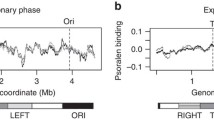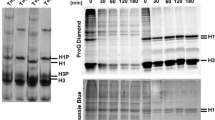Summary
-
1.
The turnover of proteins labeled with tritiated amino acids has been followed over several cell cycles in Chinese hamster cells in culture. Radioactive proteins are no longer detectable in chromosomes of the third metaphases following labeling. The experiment is interpreted as evidence of general turnover of chromosomal proteins (including histones) during cell growth and division.
-
2.
In labeling experiments with amoeba all nuclear proteins were found to undergo turnover, even in the absence of cell division.
-
3.
C14 amino acid labeling suggests that a small amount of histone synthesis may take place in the pre- and post-DNA synthesis periods.
Similar content being viewed by others
References
Allfrey, V. G., V. C. Littau, and A. E. Mirsky. 1963. On the role of histones in regulating RNA synthesis in the cell nucleus. Proc. Nat. Acad. Sci., U.S.A.49: 414–421.
Huang, R. C., and J. Bonner. 1962. Histone, a suppressor of chromosomal RNA synthesis. Proc. Nat. Acad. Sci. U.S.A.48: 1216–1222.
Birnstiel, M. L., E. Fleissner, and E. Borek. 1963. Nucleolus: A center of RNA methylation. Science142: 1577–1580.
Prescott, D. M., and M. A. Bender. 1963. Synthesis and behavior of nuclear proteins during the cell life cycle. J. Cell. Comp. Physiol. (Suppl.)62: 175–194.
Alfert, M., and I. I. Geschwind. 1953. A selective staining method for the basic proteins of cell nuclei. Proc. Nat. Acad. Sci., U.S.A.39: 991–998.
Prensky, W., and H. H. Smith. 1964. Incorporation of3H-arginine in chromosomes ofVicia faba. Exp. Cell Res.34: 525–532.
Goldstein, L. 1963. RNA and protein in nucleocytoplasmic interactions, p. 129–149.In R. J. C. Harris [ed.] Cell growth and cell division. Academic Press, Inc., New York.
Byers, T. J., D. B. Platt, and L. Goldstein. 1963. The cytonucleoproteins of amebae. I. Some chemical properties and intracellular distribution. J. Cell Biol.19: 453–466.
Byers, T. J., D. B. Platt, and L. Goldstein. 1963. The cytonucleoproteins of amebae. II. Some aspects of cytonucleoprotein behavior and synthesis. J. Cell Biol.19: 467–476.
Bloch, D. P., and G. C. Godman. 1955. A microphotometric study of the synthesis of desoxyribonucleic acid and nuclear histone. J. Biophys. Biochem. Cytol.1: 17–28.
Eagle, H., K. A. Piez, R. Fleischman, and V. I. Oyama. 1959. Protein turnover in mammalian cell cultures. J. Biol. Chem.234: 592–597.
Author information
Authors and Affiliations
Additional information
This investigation was supported in part by a grant from the National Science Foundation. Part of the work was carried out in the Biology Division of the Oak Ridge National Laboratory.
Rights and permissions
About this article
Cite this article
Prescott, D.M., Stone, G.E. Synthesis and turnover of nuclear proteins. In Vitro 1, 72–77 (1965). https://doi.org/10.1007/BF02618090
Issue Date:
DOI: https://doi.org/10.1007/BF02618090




